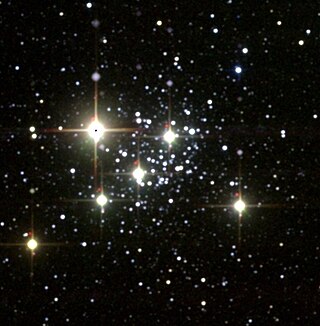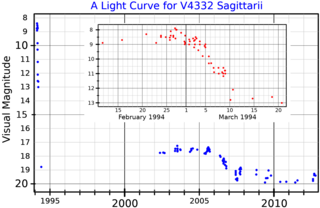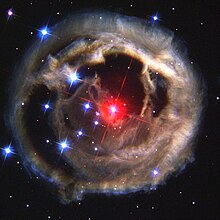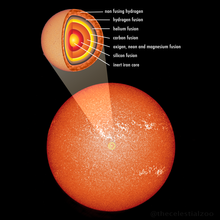
Supergiants are among the most massive and most luminous stars. Supergiant stars occupy the top region of the Hertzsprung–Russell diagram with absolute visual magnitudes between about −3 and −8. The temperature range of supergiant stars spans from about 3,400 K to over 20,000 K.

Red supergiants (RSGs) are stars with a supergiant luminosity class and a stellar classification K or M. They are the largest stars in the universe in terms of volume, although they are not the most massive or luminous. Betelgeuse and Antares A are the brightest and best known red supergiants (RSGs), indeed the only first magnitude red supergiant stars.

V838 Monocerotis is a spectroscopic binary star system in the constellation Monoceros about 19,000 light years from the Sun. The previously unremarked star was observed in early 2002 experiencing a major outburst, and was one of the largest known stars for a short period following the outburst. Originally believed to be a typical nova eruption, it was then identified as the first of a new class of eruptive variables known as luminous red novae. The reason for the outburst is still uncertain, but is thought to have been a merger of two stars within a triple system.

In astronomy, a blue giant is a hot star with a luminosity class of III (giant) or II. In the standard Hertzsprung–Russell diagram, these stars lie above and to the right of the main sequence.

A blue supergiant (BSG) is a hot, luminous star, often referred to as an OB supergiant. They have luminosity class I and spectral class B9 or earlier, although sometimes A-class supergiants are also deemed blue supergiants.

A yellow hypergiant (YHG) is a massive star with an extended atmosphere, a spectral class from A to K, and, starting with an initial mass of about 20–60 solar masses, has lost as much as half that mass. They are amongst the most visually luminous stars, with absolute magnitude (MV) around −9, but also one of the rarest, with just 20 known in the Milky Way and six of those in just a single cluster. They are sometimes referred to as cool hypergiants in comparison with O- and B-type stars, and sometimes as warm hypergiants in comparison with red supergiants.
KW Sagittarii is a red supergiant, located approximately 1,900 parsecs away from the Sun in the direction of the constellation Sagittarius. It is one of the largest-known stars. If placed at the center of the Solar System, the star's surface would engulf Mars.

A luminous red nova is a stellar explosion thought to be caused by the merging of two stars. They are characterised by a distinct red colour, and a light curve that fades slowly with resurgent brightness in the infrared. Luminous red novae are not related to standard novae, which are explosions that occur on the surface of white dwarf stars.

An O-type main-sequence star is a main-sequence star of spectral type O and luminosity class V. These stars have between 15 and 90 times the mass of the Sun and surface temperatures between 30,000 and 50,000 K. They are between 40,000 and 1,000,000 times as luminous as the Sun.

MY Cephei is a red supergiant located in open cluster NGC 7419 in the constellation of Cepheus. It is a semiregular variable star with a maximum brightness of magnitude 14.4 and a minimum of magnitude 15.5.

A yellow supergiant (YSG) is a star, generally of spectral type F or G, having a supergiant luminosity class. They are stars that have evolved away from the main sequence, expanding and becoming more luminous.

S Persei is a red supergiant or hypergiant located near the Double Cluster in Perseus, north of the cluster NGC 869. It is a member of the Perseus OB1 association and one of the largest known stars. If placed in the Solar System, its photosphere would engulf the orbit of Jupiter. It is also a semiregular variable, a star whose variations are less regular than those of Mira variables.

WOH G64 is an unusual red supergiant (RSG) star in the Large Magellanic Cloud (LMC) satellite galaxy in the southern constellation of Dorado. It is one of the largest known stars, being described as possibly being the largest star known. It is also one of the most luminous and massive red supergiants, with a radius calculated to be around 1,540 times that of the Sun (R☉) and a luminosity around 282,000 times the solar luminosity (L☉).

A hypergiant (luminosity class 0 or Ia+) is a very rare type of star that has an extremely high luminosity, mass, size and mass loss because of its extreme stellar winds. The term hypergiant is defined as luminosity class 0 (zero) in the MKK system. However, this is rarely seen in literature or in published spectral classifications, except for specific well-defined groups such as the yellow hypergiants, RSG (red supergiants), or blue B(e) supergiants with emission spectra. More commonly, hypergiants are classed as Ia-0 or Ia+, but red supergiants are rarely assigned these spectral classifications. Astronomers are interested in these stars because they relate to understanding stellar evolution, especially star formation, stability, and their expected demise as supernovae.

A red giant is a luminous giant star of low or intermediate mass in a late phase of stellar evolution. The outer atmosphere is inflated and tenuous, making the radius large and the surface temperature around 5,000 K or lower. The appearance of the red giant is from yellow-white to reddish-orange, including the spectral types K and M, sometimes G, but also class S stars and most carbon stars.
VX Sagittarii is an asymptotic giant branch star located more than 1.5 kiloparsec away from the Sun in the constellation of Sagittarius. It is a pulsating variable star with an unusually large magnitude range. It is one of the largest stars discovered, with a radius varying between 1,350 and 1,940 solar radii (940,000,000 and 1.35×109 km; 6.3 and 9.0 au). It is the most luminous known AGB star, at bolometric magnitude –8.6, which is brighter than the theoretical limit at –8.0.

An O-type star is a hot, blue-white star of spectral type O in the Yerkes classification system employed by astronomers. They have temperatures in excess of 30,000 kelvins (K). Stars of this type have strong absorption lines of ionised helium, strong lines of other ionised elements, and hydrogen and neutral helium lines weaker than spectral type B.
V1309 Scorpii is a contact binary that merged into a single star in 2008 in a process known as a luminous red nova. It was the first star to provide conclusive evidence that contact binary systems end their evolution in a stellar merger. Its similarities to V838 Monocerotis and V4332 Sagittarii allowed scientists to identify these stars as merged contact binaries as well.

V4332 Sagittarii is a nova-like event in the constellation of Sagittarius. It was discovered February 24, 1994 at an apparent visual magnitude of 8.9 by Japanese amateur astronomer Minoru Yamamoto from Okazaki, Aichi, then confirmed by K. Hirosawa. Initially designated Nova Sagittarii 1994 #1, it was given the variable star designation V4332 Sgr. A spectra of the event taken March 4 lacked the characteristic features of a classical nova, with the only emission lines being of the Balmer series. Subsequent spectra showed a rapid decline in luminosity and a change of spectral type over a period of five days. By 2003, the object was ~1500 times less luminous than at peak magnitude and showed a spectrum of an M-type star.












